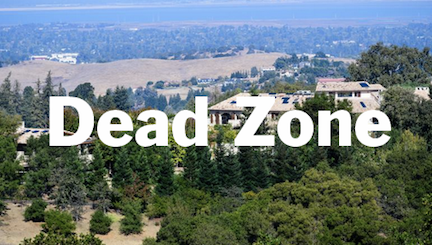
UPDATE: After this article was printed on March 21 and posted online March 30, Eric Nickel, executive director of the Silicon Valley Regional Interoperability Authority (SVRIA), wanted us to point out that the old analog radio system had similar coverage issues in the Palo Alto Foothills as the new digital system. He said that anytime there are hills, ridges and valleys, getting a radio signal into 100% of the area is impossible.
BY ELAINE GOODMAN
Daily Post Correspondent
An organization that runs a county-wide law enforcement radio system is working to fill in a “dead spot” in the Palo Alto foothills that could hinder officers’ ability to call for help when they’re in the area.
The dead spot remained after the Silicon Valley Regional Interoperability Authority, or SVRIA, completed its digital radio system in 2020.
The authority is planning to fill in the dead spot with a digital radio site called the Montebello site, according to SVRIA executive director Eric Nickel, a former Palo Alto fire chief.
The cost of the site could be as much as $3.5 million if it’s interconnected with sites in the “west cell” of the radio system, Nickel said. If the Montebello site is not interconnected, the cost would drop to about $1 million.
The benefit of the site will extend beyond Palo Alto to other foothill communities, Nickel said, and so its cost might be spread out.
Nickel said he wasn’t aware of any dangerous situations that resulted from the presence of the dead spot.
SVRIA is a joint powers authority formed in 2010 to provide communication services to public safety agencies in Santa Clara County. SVRIA’s membership includes the 15 cities in the county as well as the county itself.
SVRIA’s digital radio system is known as the Silicon Valley Regional Communications System, or SVRCS. Public safety departments in member cities can use SVRCS for day-to-day radio communications.
SVRIA contracted with Motorola for the digital radio system, and the company guaranteed 97% coverage. The company fulfilled that promise and is off the hook when it comes to paying for the Montebello site, Nickel said.
SVRIA will also have another option for areas that need additional radio coverage: a mobile radio site that’s being mostly funded by the California Office of Emergency Services.
The mobile site can be transported anywhere in Santa Clara County, serving as a temporary radio site during a large event or replacing an existing site that’s out of service or isn’t working because of a power shutoff.
Analog backup planned
Longer term, SVRIA is looking into building an analog radio system to serve as a backup for its digital system. Nickel said the backup system could be used if the digital system were knocked out by a natural disaster such as an earthquake or by a cyber attack.
The idea for the backup system arose because the Santa Clara County Sheriff’s Office is installing an analog system to provide radio coverage in some rural areas in the south and east county, according to Nickel.
SVRIA could potentially work with the sheriff’s office to expand the analog system to create a county-wide alternate radio system. The digital system would remain the primary system.
“I do see analog as a good backup system,” Nickel said.
While SVRIA staff have been discussing the potential backup system, the topic hasn’t yet made it to the authority’s board of directors, Nickel said. Those discussions could start in the next six to 12 months, he added.
A detailed plan hasn’t been developed for the backup system yet, Nickel said, and there’s no cost estimate.
The Santa Clara County Sheriff’s communication unit did not respond to requests for comment about the radio system.
Digital radio systems have been gradually replacing analog radio, which has been around for decades.
In analog radio, a person’s true voice is transmitted over a particular frequency. In contrast, digital systems convert sounds into numeric patterns that a computer can easily read.
One of the advantages of digital systems is that they can reduce background noise and static. Digital radio also allows more than one conversation per channel.
Digital radio can be encrypted in a manner that complies with a modern standard called AES 256, which SVRIA uses, according to Nickel.
Digital’s disadvantages
But digital systems can have challenges. In particular, Nickel said, the popularity of frequencies used for digital radio means that turning up the power to reach remote areas may not be an option, because the signals will then be picked up by other users in nearby areas.
Radio signals may also be blocked by the concrete and steel in large buildings. To compensate, building owners are required to install antennas to boost the radio signals.
Nickel said analog systems could also have coverage issues, depending on frequencies, locations and infrastructure.
